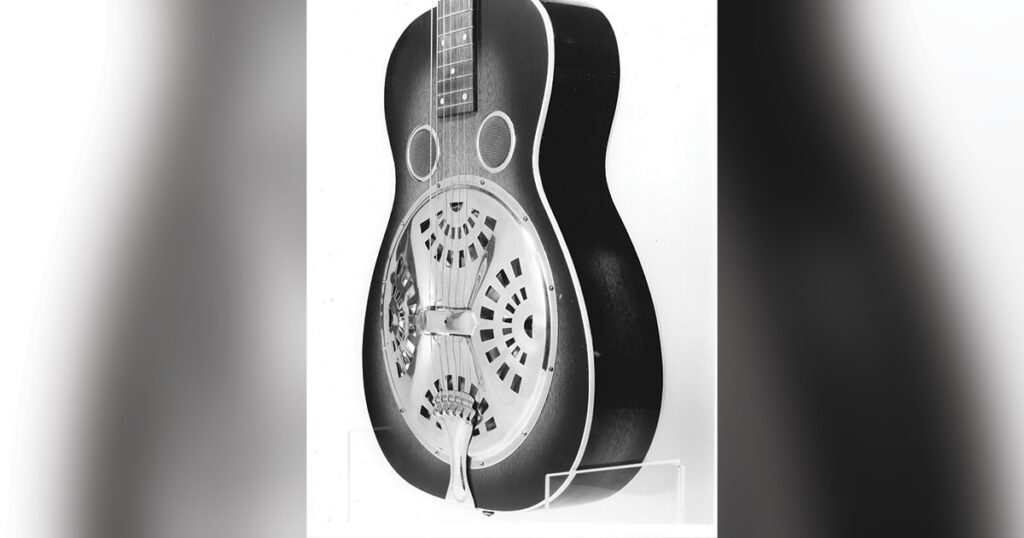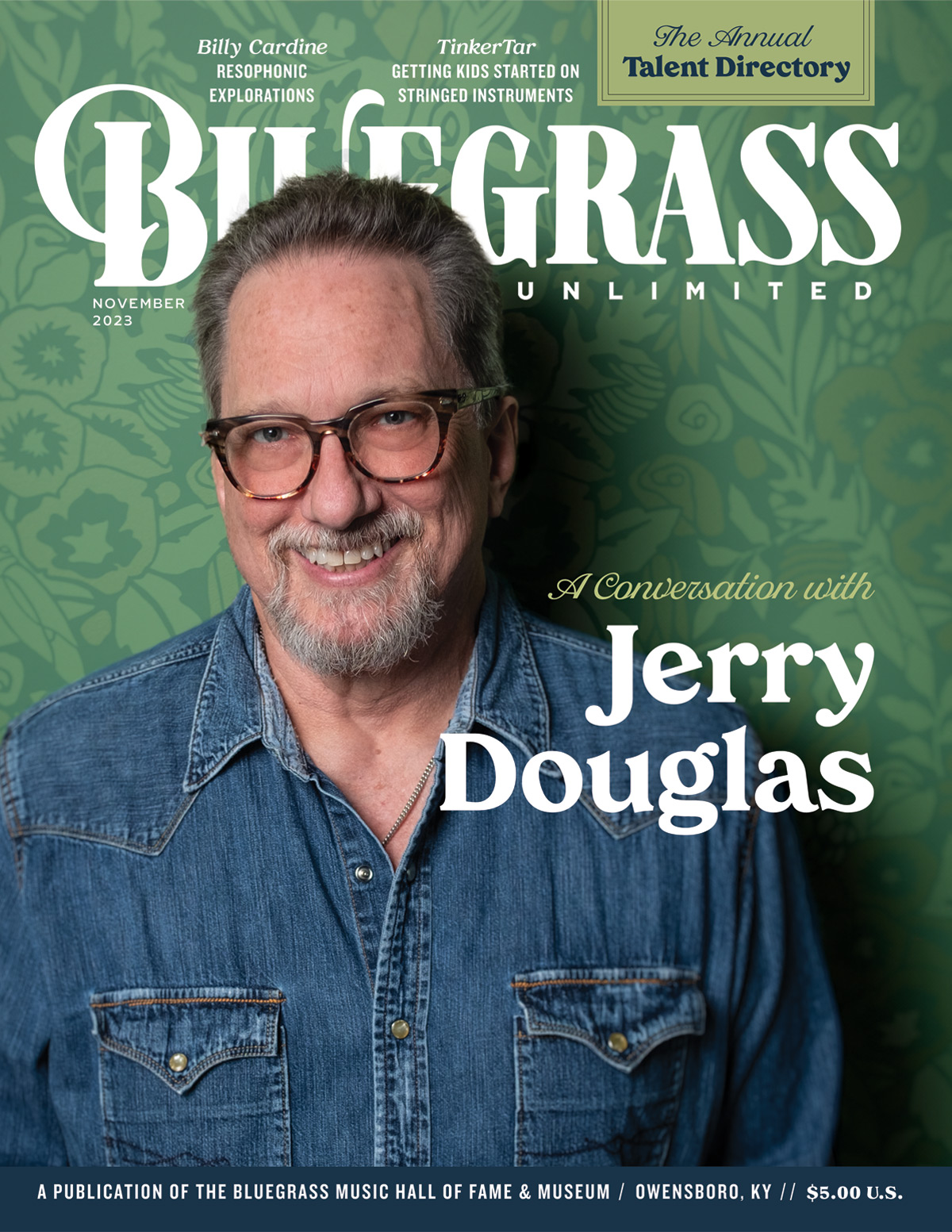Home > Articles > The Archives > The Dobro Guitar And Bluegrass
The Dobro Guitar And Bluegrass
By Russ Hooper and Randy Slacum
Reprinted from Bluegrass Unlimited Magazine
May 1967, Volume 1, Number 11
The typical bluegrass band consists of a bass, banjo, fiddle, (or mandolin) and guitar. Not typical, but included in some bands is the autoharp, harmonica, or the dobro guitar. The dobro was first made in San Francisco during 1925-26 by five brothers-the Doperas. It’s name is derived from the family name and means “good” in Russian. When the brothers first produced the dobro, it was used as a Hawaiian guitar, although this was not the original intent of the Doperas. The first dobro was simply a guitar with strings raised—then the Doperas developed the square-necked dobro we know today.
Physically the instrument has a sound very similar to the Hawaiian steel guitar- due to a 12-inch diameter, concave resonator cone used to reinforce the sound.
This resonator is mounted under the strings in the main body of the guitar. It is inverted when mounted and is bowl-shaped with a peak of on one one half inches in the center of the bowl. The cone can be either a molded or a spun type, the molded being the least preferred due to more crisp resonance from the spun type. Adjustment, can be made to the cone by turning the bolt holding the cone and bridge together. This adjustment is critical in that if tightened too much a tinny, low-volume sound will be produced and if too loose, the sound is hollow and has almost no volume.
By carefully turning this bolt one can hear the changes in tone quality (and .
volume levels) and adjust accordingly, either loosening or tightening until the dobro has a good “knock.” [“Knock” is a term used by dobro enthusiasts to describe the way sound from the dobro hits the ear. The sound should be crisp and clear, yet not linger too long lest it becomes muddy. This crispness should also be limited so that the sound is not shrill.]
To give physical support to the resonator, a spider of four, six, or eight prongs is mounted connecting bridge and resonator. Above the spider, the strings are approximately one and one half inches. This puts the strings about an inch above the finger board.
Drilled in the box, or main body, are screen holes of about 2 inches in diameter to let sound out, thereby aiding the resonator cone and making the sound richer and more full-bodied. In the square-necked original dobro there are three small holes drilled to . help the screen holes do their job of letting sound out. Further helping these sound holes and resonator cone produce a rich sound is a small barrel mounted inside the box and below the resonator with two-inch holes in it. This aids the resonator by letting out the sound produced by the resonator in a downward direction. Over this barrel, resonator, spider, bridge and strings goes a decorative perforated plate—slotted for the strings. This plate should be firmly secured since any looseness will show up as a tinny distortion when playing the dobro.
The strings are tuned to A or G for bluegrass music. The first four strings are tuned just like those of a five-string banjo. The fifth string is tuned to B and the sixth to G. The strings are wire wound and are played, depending on the player’s style, with a flat pick or with three finger picks. The chording is done by moving a steel guitar bar along the strings.
The dobro can be played either standing or sitting. In sitting, the body of the guitar is over the right knee—the neck on the left side of the player. In standing, as is traditional, the dobro is adjusted to preference by the player. In either case, standing or sitting, the steel is manipulated with the left hand and the picks (2 metal for fingers and 1 plastic for thumb) are on thumb, forefinger and middle finger of the right hand.
The Dopera brothers made this instrument for almost seven years before selling their rights to the instrument to National Music Company. The instrument was then modified and called the National Dobro. Then, after an extended lull in sales, Valeo, in Chicago in 1954 bought out National. In 1962, the two remaining Doperas started making an instrument called the “D and B Original”, a throwback type to the original Dobro. Recently Mosrite bought the two Doperas out and is producing a dobro under the name “Replica”, which as it implies, is a replica of the old square-necked dobro of 1929.
The original form of the guitar with raised strings—the 1929 dobro—had the square neck and the three holes between the screens, and remains the best-sounding of the dobros, which explains why it’s the most popular among bluegrass performers. The later modified forms (i.e. metal bodies, three prong spiders, cone reversed and not inverted) have not achieved popularity due to the lack of the authentic dobro “knock”.
The dobro’s position in a bluegrass band is one of backing-up the singer, or singers, and the other instruments. The dobro is also used as a lead instrument on breaks, just as the banjo is used. It adds a unique flavor and sound to the bluegrass band.
The dobro has been used by many groups with just as many different ways of playing it. The first extensive use of the instrument was, as pointed out before, by Hawaiian bands. Some of these groups employed the dobro in large numbers to produce the authentic island sound. The first well-known band in the country music field to use the dobro was the Smokey Mountain Boys—Roy Acuff’s group. The dobro player for the group, most of the time, was, and still is, Beecher “Pete” Kirby— “Brother Oswald”. Kirby uses a two-finger method of alternately picking two strings to produce a “glissando” run. The first and second strings are the two most used together. Other groups which started to use the dobro were: Molly O’Day and her Cumberland Mountain Folks, Gene Autry, Toby Stroud, Wilma Lee and Stoney Cooper and the Clinch Mountain Clan, Carl Story, Carl.Butler, Jimmy Rogers, Mac O’Dell, Johnny and Jack, and later, Lester Flatt and Earl Scruggs and the Foggy Mountain Boys. On some of the early Wilma Lee & Stoney Cooper records the dobro player was Bill Carver who composed “Willie Roy”. In some of the early Gene Autry recordings an all-metal National Dobro can be heard. For Mac O’Dell and Molly O’Day, George “Speedy” Krise played dobro. The Bailes Brothers used a steel guitarist who played the steel with a dobro style. Johnnie and Jack used Ray Adkins on dobro, until their recording of “Poison Love”—and after used Shot Jackson.
Lester Flatt and Earl Scruggs and the Foggy Mountain Boys, Wilma Lee and Stoney Cooper, and Toby Stroud have all used the talents of the second great innovator after Beecher-Kirby, Buck Graves (Uncle Josh). (Flatt and Scruggs still use his talents.) Graves established the dobro as a bluegrass instrument by adopting and perfecting the three-finger bluegrass banjo style of Earl Scruggs. This three-finger roll method has come to be more suitable to the driving style of today’s bluegrass than Oswald’s two finger glissando method. Graves remains the-outstanding dobro player of today as can be evidenced by anyone who has heard his lightning-fast rendition of his own instrumental—”Fireball.”
The two main bluegrass styles, then, are the Graves and the Oswald. Most dobro players, combine these two styles to their own (and their band’s) needs. A unique style—not Graves or Oswald, is the one used by Tut Taylor. Taylor plays the dobro with a flat pick instead of the conventional finger picks.
The dobro has developed as a unique sounding guitar—from Hawaiian to bluegrass styles, to current pop music (as evidenced by the number of gut-string dobros used to back-up pop singers, i.e. Nancy Sinatra). However, the dobro’s different sound requiring no amplification to reach respectable volume levels lends itself to bluegrass music especially. From Brother Oswald to Uncle Josh with many lesser known, but accomplished performers between, the dobro has proved itself a solid contributor to the vitality and drive of bluegrass music.
Share this article
1 Comment
Leave a Comment Cancel Reply
This site uses Akismet to reduce spam. Learn how your comment data is processed.


Don’t forget the great sound of Russ Hooper.